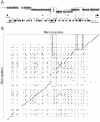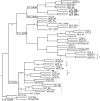Dynamic evolution of V1R putative pheromone receptors between Mus musculus and Mus spretus
- PMID: 19203383
- PMCID: PMC2644715
- DOI: 10.1186/1471-2164-10-74
Dynamic evolution of V1R putative pheromone receptors between Mus musculus and Mus spretus
Abstract
Background: The mammalian vomeronasal organ (VNO) expresses two G-protein coupled receptor gene families that mediate pheromone responses, the V1R and V2R receptor genes. In rodents, there are ~150 V1R genes comprising 12 subfamilies organized in gene clusters at multiple chromosomal locations. Previously, we showed that several of these subfamilies had been extensively modulated by gene duplications, deletions, and gene conversions around the time of the evolutionary split of the mouse and rat lineages, consistent with the hypothesis that V1R repertoires might be involved in reinforcing speciation events. Here, we generated genome sequence for one large cluster containing two V1R subfamilies in Mus spretus, a closely related and sympatric species to Mus musculus, and investigated evolutionary change in these repertoires along the two mouse lineages.
Results: We describe a comparison of spretus and musculus with respect to genome organization and synteny, as well as V1R gene content and phylogeny, with reference to previous observations made between mouse and rat. Unlike the mouse-rat comparisons, synteny seems to be largely conserved between the two mouse species. Disruption of local synteny is generally associated with differences in repeat content, although these differences appear to arise more from deletion than new integrations. Even though unambiguous V1R orthology is evident, we observe dynamic modulation of the functional repertoires, with two of seven V1Rb and one of eleven V1Ra genes lost in spretus, two V1Ra genes becoming pseudogenes in musculus, two additional orthologous pairs apparently subject to strong adaptive selection, and another divergent orthologous pair that apparently was subjected to gene conversion.
Conclusion: Therefore, eight of the 18 (~44%) presumptive V1Ra/V1Rb genes in the musculus-spretus ancestor appear to have undergone functional modulation since these two species diverged. As compared to the rat-mouse split, where modulation is evident by independent expansions of these two V1R subfamilies, divergence between musculus and spretus has arisen more by mutations within coding sequences. These results support the hypothesis that adaptive changes in functional V1R repertoires contribute to the delineation of very closely related species.
Figures




Similar articles
-
Rapid turnover and species-specificity of vomeronasal pheromone receptor genes in mice and rats.Gene. 2004 Oct 13;340(2):303-12. doi: 10.1016/j.gene.2004.07.037. Gene. 2004. PMID: 15475172
-
Divergent V1R repertoires in five species: Amplification in rodents, decimation in primates, and a surprisingly small repertoire in dogs.Genome Res. 2005 Feb;15(2):231-40. doi: 10.1101/gr.3339905. Epub 2005 Jan 14. Genome Res. 2005. PMID: 15653832 Free PMC article.
-
Species specificity in rodent pheromone receptor repertoires.Genome Res. 2004 Apr;14(4):603-8. doi: 10.1101/gr.2117004. Genome Res. 2004. PMID: 15060001 Free PMC article.
-
Evolution of V1R pheromone receptor genes in vertebrates: diversity and commonality.Genes Genet Syst. 2019 Oct 30;94(4):141-149. doi: 10.1266/ggs.19-00009. Epub 2019 Oct 2. Genes Genet Syst. 2019. PMID: 31474650 Review.
-
Vomeronasal Receptors in Vertebrates and the Evolution of Pheromone Detection.Annu Rev Anim Biosci. 2017 Feb 8;5:353-370. doi: 10.1146/annurev-animal-022516-022801. Epub 2016 Nov 28. Annu Rev Anim Biosci. 2017. PMID: 27912243 Review.
Cited by
-
Genome sequence of walking catfish (Clarias batrachus) provides insights into terrestrial adaptation.BMC Genomics. 2018 Dec 20;19(1):952. doi: 10.1186/s12864-018-5355-9. BMC Genomics. 2018. PMID: 30572844 Free PMC article.
-
Comparative Genomic Analysis of the Pheromone Receptor Class 1 Family (V1R) Reveals Extreme Complexity in Mouse Lemurs (Genus, Microcebus) and a Chromosomal Hotspot across Mammals.Genome Biol Evol. 2020 Jan 1;12(1):3562-3579. doi: 10.1093/gbe/evz200. Genome Biol Evol. 2020. PMID: 31555816 Free PMC article.
-
Coding of pheromones by vomeronasal receptors.Cell Tissue Res. 2021 Jan;383(1):367-386. doi: 10.1007/s00441-020-03376-6. Epub 2021 Jan 12. Cell Tissue Res. 2021. PMID: 33433690 Review.
-
Molecular evolutionary characterization of a V1R subfamily unique to strepsirrhine primates.Genome Biol Evol. 2014 Jan;6(1):213-27. doi: 10.1093/gbe/evu006. Genome Biol Evol. 2014. PMID: 24398377 Free PMC article.
-
Convergent reduction of V1R genes in subterranean rodents.BMC Evol Biol. 2019 Aug 30;19(1):176. doi: 10.1186/s12862-019-1502-4. BMC Evol Biol. 2019. PMID: 31470793 Free PMC article.
References
Publication types
MeSH terms
Substances
Grants and funding
LinkOut - more resources
Full Text Sources
Research Materials

